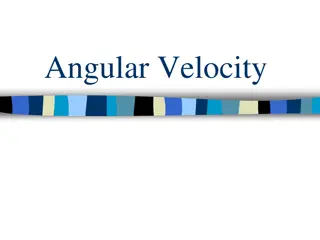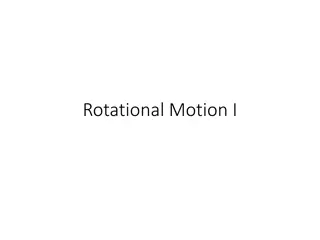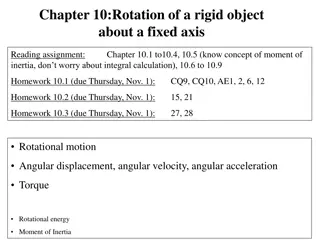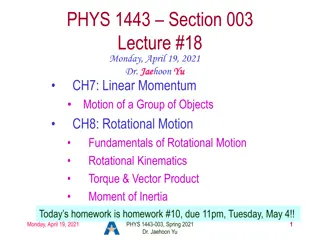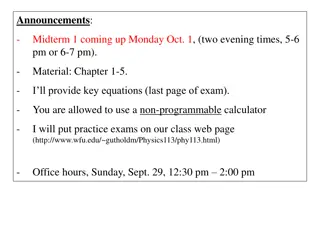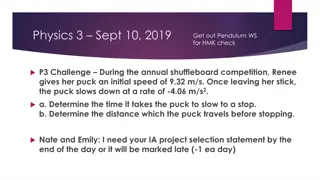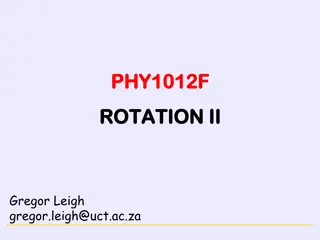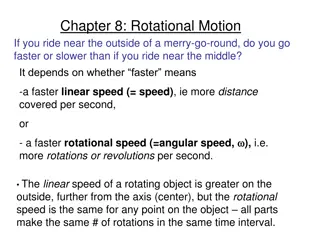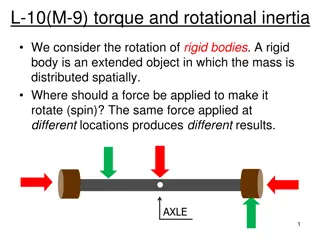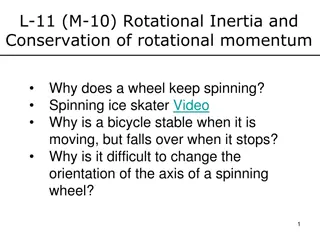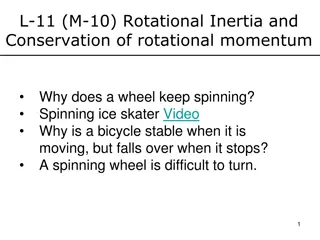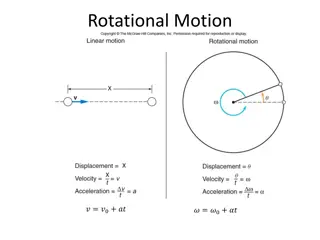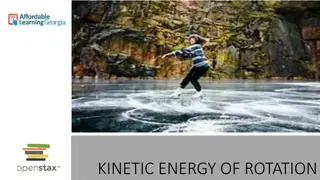Understanding Rotational Motion in Physics
Explore key concepts in rotational motion through common scenarios like a point on a bicycle tire, determining centripetal forces in roller coasters, and understanding the forces at play in loops. Discover the relationship between mass, radius, and centripetal force, as well as the forces involved at different points along a roller coaster track. Delve into the fundamentals of centripetal acceleration and the role of different forces in maintaining circular motion.
Download Presentation

Please find below an Image/Link to download the presentation.
The content on the website is provided AS IS for your information and personal use only. It may not be sold, licensed, or shared on other websites without obtaining consent from the author. Download presentation by click this link. If you encounter any issues during the download, it is possible that the publisher has removed the file from their server.
E N D
Presentation Transcript
Consider a point on a bicycle tire that is momentarily in contact with the ground as the bicycle rolls across the ground with constant speed. The direction for the centripetal acceleration for this point at that moment is: 1. upward. 2. down toward the ground. 3. forward. 4. at that moment the acceleration is zero. 0% 0% 0% 0% upward. forward. down toward the ground. at that moment the acce...
A roller coaster has two loops of different radii. Which will have the greater centripetal force? 1. loop with greater radius 2. loop with smaller radius 3. both have the same 4. not enough information 0% 0% 0% 0% both have the same loop with smaller radius not enough information loop with greater radius
The Gemini roller coaster has two cars of differing mass. Which will have a greater centripetal force at the bottom of the first hill? 1. Car with more mass 2. Car with less mass 3. Both have the same 4. not enough information 0% 0% 0% 0% Car with more mass Car with less mass Both have the same not enough information
A roller coaster has two loops of different radii. What forces provide the centripetal force at the top of the loop? 1. 2. 3. Normal force Gravitational force Normal Force + Gravitational Force Normal Force - Gravitational Force Gravitational Force Normal Force Frictional Force 4. 0% 0% 0% 0% 0% 0% 5. Normal force Frictional Force Gravitational force Normal Force + Gravitat... Normal Force - Gravitat... Gravitational Force N... 6.
In a looped roller coaster, what force(s) provide the centripetal force at the top of the loop at the minimum speed needed to get over the loop? 1. 2. 3. Normal force only Gravitational force only Normal Force + Gravitational Force Normal Force - Gravitational Force Gravitational Force Normal Force Frictional Force 4. 0% 0% 0% 0% 0% 0% 5. Frictional For... Gravitational ... Gravitational ... Normal force o... Normal Force +... Normal Force -... 6.
A roller coaster has two loops of different radii. What forces provide the centripetal force at the bottom of the loop? 1. 2. 3. Normal force Gravitational force Normal Force + Gravitational Force Normal Force - Gravitational Force Gravitational Force Normal Force Frictional Force 4. 0% 0% 0% 0% 0% 0% 5. Normal force Frictional Force Gravitational force Normal Force + Gravitat... Normal Force - Gravitat... Gravitational Force N... 6.
A roller coaster has two loops of different radii. What forces provide the centripetal force directly to the left of the loop? 1. 2. 3. Normal force Gravitational force Normal Force + Gravitational Force Normal Force - Gravitational Force Gravitational Force Normal Force Frictional Force 4. 0% 0% 0% 0% 0% 0% 5. Normal force Frictional Force Gravitational force Normal Force + Gravitat... Normal Force - Gravitat... Gravitational Force N... 6.
What gives the centripetal force that allows a motorcycle to drive around the inside of a cage? 1. Frictional 2. Gravitational 3. Normal 4. Tensional 5. Applied 0% 0% 0% 0% 0% Normal Applied Tensional Frictional Gravitational
What gives the centripetal force that keeps the moon revolving around the Earth? 1. Frictional 2. Gravitational 3. Normal 4. Tensional 5. Applied 0% 0% 0% 0% 0% Normal Applied Tensional Frictional Gravitational
Two adjacent lanes are curving. If the lanes are flat, what provides the centripetal force? 1. 2. 3. Normal force Gravitational force Normal Force + Gravitational Force Frictional Force 4. 0% 0% 0% 0% Normal force Gravitational... Frictional For... Normal Force +...
Two adjacent lanes are curving. Which lane should you choose if you want to minimize the centripetal force? 1. inner lane 2. outer lane 3. both have same force 4. unable to be determined 0% 0% 0% 0% inner lane outer lane both have same force unable to be determined
A lane on the highway is curving and you feel forced towards the outside of the curve as you drive. The most direct cause of this is: 1. 2. 3. 4. 5. Normal force Gravitational force Inertia Centrifugal force Centripetal force 0% 0% 0% 0% 0% Inertia Normal force Gravitational... Centripetal fo... Centrifugal fo...
How is gravitational force proportional to the distance between two objects? 1. Directly 2. Inversely 3. No Correlation 0% 0% 0% Directly Inversely No Correlation
How is gravitational force proportional to the mass of two objects? 1. Directly 2. Inversely 3. No Correlation 0% 0% 0% Directly Inversely No Correlation
How is gravitational force proportional to the volume of two objects? 1. Directly 2. Inversely 3. No Correlation 0% 0% 0% Directly Inversely No Correlation
On vacation, you go to the Grand Canyon and walk down to the bottom of the canyon. During this walk what happened to your weight? 1. Weight increased 2. Weight decreased 3. No change 4. Not enough information 0% 0% 0% 0% No change Weight increased Weight decreased Not enough information
You travel to another planet that has twice the radius of the Earth but the same mass. Compared to your weight on Earth, your weight will 1. Double 2. Be cut in half 3. Be your weight on Earth 4. The same 0% 0% 0% 0% Double The same Be cut in half Be your weight on Earth
Which will produce the most torque? 1. 5N force exerted .2m from the axis 2. 10N force exerted .2m from the axis 3. 20N force exerted .01m from the axis 4. 5N force exerted .3m from the axis 0% 0% 0% 0% 20N force exerted .01m ... 5N force exerted .2m fr.. 5N force exerted .3m fr.. 10N force exerted .2m f...
What is a way to increase the torque on an object? 1. Exert more force. 2. Exert the same force at a greater distance from the fulcrum. 3. Exert a lesser force closer to the fulcrum. 4. Both 1 and 2 are correct 5. All of the above 0% 0% 0% 0% 0% Exert more force. All of the above Both 1 and 2 are correct Exert a lesser force close... Exert the same force at a...
Which of the following produces positive torque on a lever? 1. A parallel force 20cm from the axis A perpendicular force upward 20cm to the right of the axis A perpendicular force upward 20cm to the left of the axis A perpendicular force downward 20cm to the right of the axis 2. 3. 4. 0% 0% 0% 0% A parallel for... A perpendicula... A perpendicula... A perpendicula...
The average position of an objects weight is the 1. Fulcrum 2. Center of mass 3. Gravitational Force 4. Lever 5. Axis of rotation 0% 0% 0% 0% 0% Lever Fulcrum Center of mass Axis of rotati... Gravitational ...
An object in rotational equilibrium has 1. No torque applied 2. A constant tangential speed 3. A net torque of zero 4. An axis of rotation 0% 0% 0% 0% No torque appl... A net torque o... A constant tan... An axis of rot...





